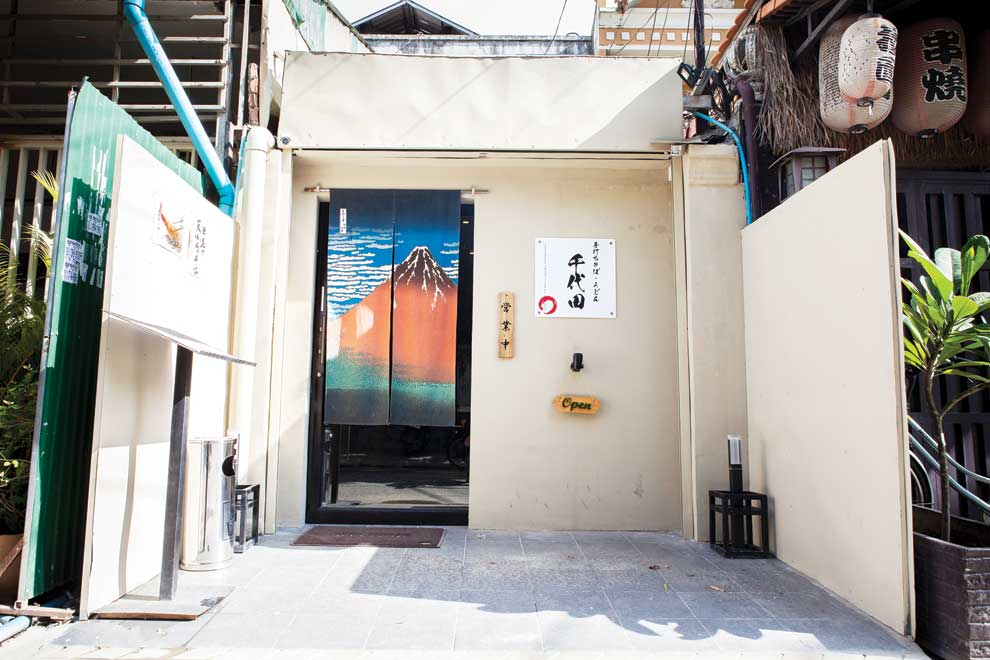
The finished product: a plate of soba noodles crafted by chef Nobuhiko Kado.
Inside a glass-paned room, buckwheat and wheat flour are sifted into a large lacquered kibachi bowl, and Nobuhiko Kado, known as Nobu, who trained seven years to hand-make soba noodles, begins the laborious process of kneading the dough. Within 10 minutes, he has rolled a neat ball of dough, laid it out on a wood board, and flattened it into a thin square sheet using a set of rolling pins.
Nobu flours the dough as he folds it over several times before unsheathing a special cleaver which, paired with a rectangular guide in one hand, he uses to cut and trim the dough into bunches of noodles. They are then laid on a tray to be served up that evening as either hot kake or cold zaru soba.
Named after the central ward of Tokyo where the emperor resides, Chiyoda – Nobu’s restaurant – will be “the first handmade soba and udon place in Cambodia” when it formally opens in September, says supervisor Isato Yoshino.
“We have been testing many different buckwheat [flours] to find the best one,” he says, adding that the import of flour from Japan, Myanmar and Mongolia did not go unnoticed.
“We are bringing in all these white powders, so airport customs was very suspicious,” Yoshino chuckles.
The challenges went further than that: Cambodia’s humidity and high temperatures mean that making a long soba noodle in the tradition of Tokyo and northeastern Japan was far from trivial.
“The ratio of the buckwheat flour to the wheat flour is very important,” he says.

Chef Nobu at work. Athena Zelandonii
In Cambodia, too much buckwheat will cause the soba noodle to fall apart. Udon noodles, by comparison, are made only of wheat and are much thicker. That means udon noodles “are not so sensitive – that is a difference. Udon can last five days after it is made; soba, not
even one day,” Yoshino says.
“Anything not sold by 10pm, we dump,” he adds.
For this reason, Nobu works in a climate-controlled room but with glass panes that allow patrons to watch his handicraft. Being in Phnom Penh has an advantage: a serving of handmade soba at Chiyoda costs $5, roughly half the price in Tokyo, but with no sacrifice in quality.
Yoshino crowd-tested the soba on Japanese patrons who filled out questionnaires during the five-week soft opening, ensuring that – beyond the markedly Japanese interior, complete with ’90s Japanese rock music – the restaurant offers an authentic soba experience.
“I want the customer to feel like they are in Japan,” he says. Even the photographs on the wall, works by Yoshino’s father Junji – a former photojournalist for the weekly financial magazine Toyo Keizai – reflect what season it is back home.

Chiyoda’s unassuming exterior disguises the excellence within. Athena Zelandonii
But soba is more than just a buckwheat noodle. Boasting a 500-year history, the noodle is meant to be eaten with just its broth, wasabi and green onions, and while Yoshino has meat add-ons such as shrimp tempura on the menu to satisfy customers, “in reality, in Japanese [tradition], we prefer simplicity,” he says.
As such, properly eating cold zaru soba requires a bit of traditional know-how. Luckily, though, a step-by-step illustration on the back of the English-language menu teaches you how to garnish and dip your noodles before sucking them up.
“You can slurp,” he says. “It happens, and in Japan it is not rude to make a noise [while eating].”
Chiyoda is located on #22 Street 334, and is open from 11:30am to 2:30pm and 5:30p to 10pm, seven days a week. Tel: 011 962 665.
Contact PhnomPenh Post for full article
SR Digital Media Co., Ltd.'#41, Street 228, Sangkat Boeung Raing, Khan Daun Penh, Phnom Penh, Cambodia
Tel: +855 92 555 741
Email: webmasterpppost@gmail.com
Copyright © All rights reserved, The Phnom Penh Post







